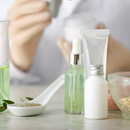
Every rule has its exception. While we all agree that making the switch to natural beauty alternatives is beneficial to us and our families, not everything that is natural is a better option.
Case in point, Petroleum.Petroleum is made from the residue of plants, plankton and algae that have been exposed to incredibly high temperatures and pressure within the Earth's crust. It's as natural as natural gets, but I am sure you would never think of slathering it on your skin.Unfortunately, chances are you're doing it unwittingly every morning! The ugly truth is that the beauty industry is overflowing with petrochemicals (ingredients derived from petroleum). They are literally everywhere from mascara formulas to lipsticks to moisturizers, body lotions, shampoos, conditioners, eye shadows, foundations, perfumes...you name it.

Petrochemicals are widely used in cosmetic products for different reasons: they moisturize skin, help the products glide on more smoothly, extend the shelf life of your lotions and potions and disperse fragrance evenly throughout a product. The problem is that they're often difficult to spot on the label. It's rare you'll find the word "Petroleum" on ingredient lists. Instead, it is often listed under different names, which makes it all the more hard to remember.
Aside from the ick factor, why should you be concerned? Below are a few reasons why you want to educate yourself on petrochemicals and how to recognize them on the label:
Petrochemicals create a barrier on skin
Mineral oil, petrolatum and paraffin wax are the most famous members of the petrochemical family. These ingredients are widely used in the beauty industry because of their occlusive properties: they create a barrier on the skin that many conventional cosmetics brands use to help keep even the driest of skin feeling hydrated for longer. But, there's a price to pay for that. This barrier can cause dirt, oil and any comedogenic ingredients that may be lurking in your cosmetic products to stick to skin, clogging pores and leading to the appearance of pimples and blackheads. Even more worryingly, perhaps, when used in certain products this barrier may interfere with the skin's natural perspiration process, inhibiting the associated feeling of detoxification.

Some petrochemicals can become contaminated with carcinogenic impurities
The main concern with petrochemicals is their capacity to generate 1,4-dioxane, a dangerous impurity that is a known carcinogen with links to negative effects on kidneys, respiratory tract and nervous system. Scary fact - this is also one of the main contaminants in groundwater! Although the amount of 1,4-dioxane release in cosmetics is considered by the scientific community to be too low to trigger these diseases, their widespread use is reason enough for health-conscious individuals to want to reduce their exposure to it as much as possible!
Stage names for petrochemicals in cosmetics
Here's a list of petrochemicals used in cosmetics and how best to recognize them. Remember, not all petrochemical ingredients are equal when it comes to safety. Some, like Ethanol, rank low (1-2 hazard score) on EWG's Skin Deep ingredient database while others like Phenoxyethanol rank higher as moderate hazard (3-6 hazard score); so it's best to check with the resource before you rush to conclusions, too!
- Anything ending in “eth” (it means it was made with the petrochemical ethylene oxide. Examples: Oleth, Laureth...)
- Anything with “butyl-” (examples: Butylparaben, Butyl Alcohol)
- Anything with DEA (example: Diethanolamine)
- Anything with “ethyl-” (example: Ethyl Alcohol)
- Anything with MEA (example: Ethanolamine)
- Anything with “methyl-” (example: Methylparaben)
- Anything with PEG (example: Polyethylene Glycol)
- Anything with “propyl-” (examples: Propylene Glycol, Cocamidopropyl Betaine)
- Benzene
- Butanol
- Ethanol
- Methanol
- Mineral Oil
- Paraffin Wax
- Parfum/Fragrance (up to 95{97670b28961483d4d20f4b24a0c23fa72e4f9356946e2f3433625d93de7d7130} of chemicals used in perfume can be derived from petroleum)
- Phenoxyethanol
- Toluene
We hope this article will help you better understand and gauge the ingredients in your beauty, personal, and cleaning products. This one is a biggie (as you can tell from the above list) so it might take a while to get accustomed to recognizing them but it's well worth it!
Share:
Leave a comment
Your email address will not be published. Comments will be approved before showing up. Required fields are marked *





